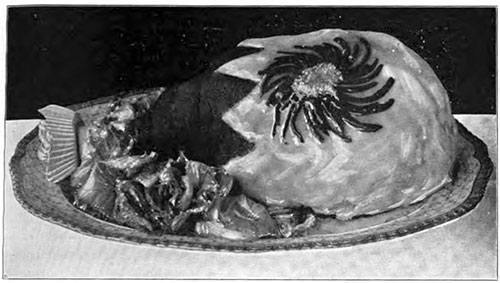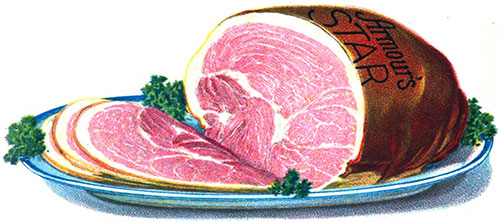Boiling - Vintage Cooking Process

Boiled Ham with ChauFroid Sauce © 1916 American Cookery
The word boiling originates from the French bouillir, to boil, i.e., to be in bubbling motion. The term bubbling applied to cookery, means cooking in boiling liquid.
Boiling means to immerse the food in water or liquid at a temperature of 212 degrees Fahrenheit or the boiling point at normal atmospheric pressure. Simmering indicates gentle boiling. In simmering some portion of the liquid is boiling but in boiling proper every portion of the vessel of water has reached the required temperature.
Both boiling and steaming are known as the simplest, most economical, as well as the most common forms of cooking. Meat loses less weight by boiling or steaming than by any other process.
In case of boiling, the liquid i.e., the water in which meat is boiled can be turned to good account. Boiled food is considered wholesome, and is easily digested.
Special Points
Special points to be observed in boiling are: That the water should at all times be kept so as to cover the meat or vegetables or other things to be cooked. If it evaporates, it is best to add boiling water, because the sudden introduction of cold water will lower the temperature, which is not always advisable.

Boiled Boneless Star Ham from Armour © 1917 The Business of Being a Housewife
In boiling meat, the addition of vegetables, such as carrots, turnips, onions, or celery, is a decided improvement, for thereby the flavor of the article boiled, as well as the liquor or broth, will be much better.
The exact time for boiling and steaming cannot be fixed in an arbitrary manner, as is the case with roasting. It varies from ten to forty minutes to the pound. Discretion, as well as experience are the best guides to decide this question.
Boiling meats, fish and vegetables is, within certain limits, the simplest and easiest process of cooking. Boiling implies a process of cooking effected by immersion for a certain period in boiling water or stock.
Literally, the expression boiling is both vague and often incorrectly applied, as in most cases we do not really boil the food actually; it is only the surrounding liquid that bubbles or boils.
Different Boiling Points
All liquids do not boil at the same degree; but to boil water or stock means raising them to a temperature of 212 degrees F., though in the strict sense, there is very little cooking performed at this head; most, in fact, is done a little below, which is the degree for simmering, slow boiling, steaming; or else considerably above it, as is the case with fats or oils, and these also have their boiling point. Milk will boil at a lower temperature than water, whilst slow and gentle simmering often works out as low as 170 degrees, never reaching 212 degrees,
Simmering Foods Properly
Proper simmering heat is 180 degrees. Boiling embraces two distinct objects which differ considerably. One is to retain as much as possible of the juices in the flesh, and the other is to extract the juices and to mix them with the water or other liquor in which the article is boiled.
To effect the first named purpose, that is, to retain the largest practicable proportion of gravy in a joint of meat, the meat to be boiled should be put into fast boiling water, and be allowed to boil sharply for a few minutes only, whereby the closing up of the pores of cut ends of the soft fibers will be effected, for as soon as these ends have become hardened from the coagulation of the albumen, the leakage or exudation of the juices will cease.
It is stated that albumen coagulates at as low a temperature as 120 degrees, so that a few minutes' immersion in boiling water, which has a heat of 212 degrees, should amply suffice to prevent much of the juice from escaping.
After this is effected, the cooking must be continued at a lower temperature till the joint is thoroughly done. On the other hand, if meat is put in cold water and allowed to boil up slowly and is then simmered until tender, it will be found that much of the nutritive juices have become incorporated in the water, which is then called broth. If this be carefully done, both meat and broth can be consumed, so that there cannot be much loss of nutritive matter.
Special Circumstances
Salt meats, such as salt beef, salt pork, tongues, ham and other salt, pickled or smoked meat should be put on in cold water. The time allowed for boiling meats is from twenty to twenty-five minutes for every pound, according to the size and kind of meat, and from fifteen to twenty minutes over.
A leg of mutton weighing from ten to twelve pounds will require from three to three and a half hours, if gently cooked.
Fowls take from forty minutes to one and a half hours, according to size and age.
Smoked ham and tongue should always be soaked in cold water for at least twelve hours. A large ham requires from five to six hours to cook.
Table Talk: The American Authority upon Culinary Topics and Fashions of the Table, Vol. XXVII, 1912, A Series of Articles Published Throughout the Year. Published Monthly by The Arthur H. Crist Co., Cooperstown, NY. A Monthly Magazine Devoted to the Interests of American Housewives, Having special reference to the Improvement of the Table. Marion Harris Neil, Editor.
Slow Boil and Rapid Boil - Is there a difference?
Boiling is cooking in boiling water. Solid food so cooked is called boiled food, though literally this expression is incorrect. Examples: boiled eggs, potatoes, mutton, etc. Water boils at 212° F. (sea level), and simmers at 185° F. Slowly boiling water has the same temperature as rapidly boiling water, consequently is able to do the same work, — a fact often forgotten by the cook, who is too apt "to wood" the fire that water may boil vigorously.
Watery vapor and steam pass off from boiling water. Steam is invisible : watery vapor is visible, and is often miscalled steam. Cooking utensils commonly used permit the escape of watery vapor and steam; thereby much heat is lost if food is cooked in rapidly boiling water.
Purpose of Boiling
Water is boiled for two purposes: first, cooking of itself to destroy organic impurities; second, for cooking foods. Boiling water toughens and hardens albumen in eggs; toughens fibrin and dissolves tissues in meat; bursts starch-grains and softens cellulose in cereals and vegetables.
Milk should never be allowed to boil. At boiling temperature (214° F.) the casein is slightly hardened, and the fat is rendered more difficult of digestion. Milk heated over boiling water, as in a double boiler, is called scalded milk, and reaches a temperature of 196° F. When foods are cooked over hot water the process is called steaming.
Rules for Boiling Meat
Put all meat, with the exception of tough sinewy pieces, and salted meats, into boiling water. Let the water well boil up after the meat is in it, then skim it, and lower the heat of the water to simmering point, and continue to cook it at this lower heat until the joint is tender.
The general rule given as regards the length of time to be allowed for cooking is a quarter of an hour to the pound, but this rule cannot always be followed, because the size and shape of the joint must be taken into consideration as well as its weight; also whether it has much bone or whether it is solid meat throughout.
Meat that has been well hung will cook in a shorter time than meat which has been freshly killed. It is, therefore, impossible to lay down hard and fast rules; experience is the best guide. Salt meat should be put into lukewarm water, to draw out some of the salt, and then bo simmered until cooked.
Twenty minutes to a pound should always be allowed in cooking salt meat, as salt hardens the fiber of the meat; and it therefore requires longer cooking to make it tender.
Veal and pork are also allowed twenty minutes to the pound. When boiling meat, remove all the scum from the surface of the water—if this is not done it will settle on the joint and discolor it.
The reasons for these rules are these—there is a substance in meat resembling white of egg, called albumen : by plunging the meat into boiling water, the albumen on the outside is hardened and a casing formed, which serves to keep in, so far as it is possible to do so, the flavor and juices of the joint; the heat of the water is then lowered to simmering point, because if kept boiling the joint would be hardened.
At simmering point the albumen becomes set without hardening, and the fiber is softened. The old-fashioned plan was to put the joint into cold water, and afterwards boil it quickly, a method which served to make the meat tough, and, to some extent, tasteless, the action of the cold water being to dissolve the albumen, much of which, with other nutritious properties, was drawn out and wasted.
Salt meat is put into lukewarm water that some of the salt may be drawn out. Tough sinewy pieces should also be put into lukewarm water, as they soften better than when they are put into boiling water.
There is no economy in using salt meat; it may be cheaper than fresh, but in the process of salting, the juices are, to a great extent, lost; again, in cooking it, the lukewarm water into which it must be placed to draw out some of the salt draws out also more of the juices.
The gravy for boiled joints, such as leg of mutton and silverside of beef, is usually only a little of their liquor poured over them.
Fannie Merritt Farmer, The Boston Cooking-school Cook Book, Revised Edition, Boston: Little, Brown, and Company (1912), p. 18-19
